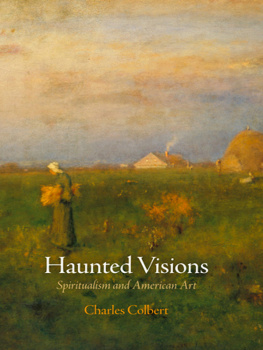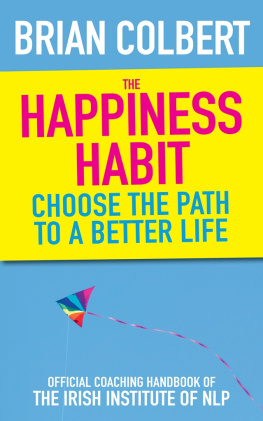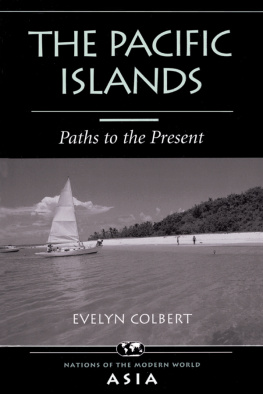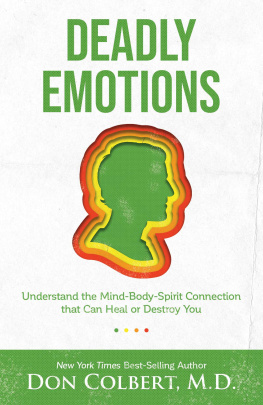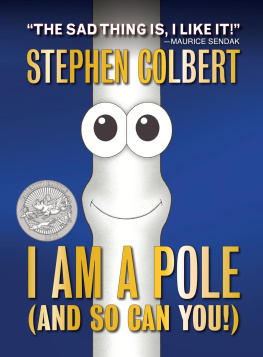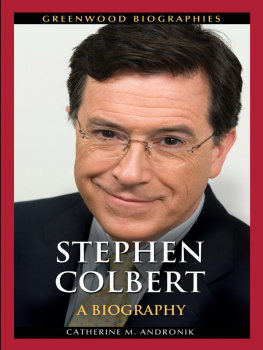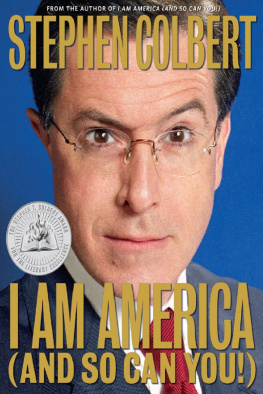Colbert - Haunted visions: spiritualism and American art
Here you can read online Colbert - Haunted visions: spiritualism and American art full text of the book (entire story) in english for free. Download pdf and epub, get meaning, cover and reviews about this ebook. City: Philadelphia;United States, year: 2011, publisher: University of Pennsylvania Press, genre: Religion. Description of the work, (preface) as well as reviews are available. Best literature library LitArk.com created for fans of good reading and offers a wide selection of genres:
Romance novel
Science fiction
Adventure
Detective
Science
History
Home and family
Prose
Art
Politics
Computer
Non-fiction
Religion
Business
Children
Humor
Choose a favorite category and find really read worthwhile books. Enjoy immersion in the world of imagination, feel the emotions of the characters or learn something new for yourself, make an fascinating discovery.
Haunted visions: spiritualism and American art: summary, description and annotation
We offer to read an annotation, description, summary or preface (depends on what the author of the book "Haunted visions: spiritualism and American art" wrote himself). If you haven't found the necessary information about the book — write in the comments, we will try to find it.
Colbert: author's other books
Who wrote Haunted visions: spiritualism and American art? Find out the surname, the name of the author of the book and a list of all author's works by series.
Haunted visions: spiritualism and American art — read online for free the complete book (whole text) full work
Below is the text of the book, divided by pages. System saving the place of the last page read, allows you to conveniently read the book "Haunted visions: spiritualism and American art" online for free, without having to search again every time where you left off. Put a bookmark, and you can go to the page where you finished reading at any time.
Font size:
Interval:
Bookmark:

Copyright 2011 University of Pennsylvania Press
All rights reserved. Except for brief quotations used for purposes of review or scholarly citation, none of this book may be reproduced in any form by any means without written permission from the publisher.
Published by
University of Pennsylvania Press
Philadelphia, Pennsylvania 19104-4112
www.upenn.edu/pennpress
Printed in the United States of America on acid-free paper
2 4 6 8 1 0 9 7 5 3 1
Library of Congress Cataloging-in-Publication Data
Colbert, Charles, 1946
Haunted visions : spiritualism and American art / Charles Colbert. 1st ed.
p. cm.
Includes bibliographical references and index.
ISBN 978-0-8122-4325-3 (hardcover : alk. paper)
1. Art, American19th century. 2. SpiritualismUnited StatesHistory. 3. Spiritualism in art. I. Title.
N6510.C65 2011
701'.08dc22 2011001800
___________
__________
The History and Teachings of Spiritualism
The flourishing of Spiritualism in the second half of the nineteenth century coincided with a growing willingness on the part of many Americans to hold the fine arts in high esteem. The simultaneity was not entirely fortuitous. Puritan austerity and republican simplicity seemed increasingly pass to the consumer culture that emerged in the Victorian era. But old mores had to be replaced with new ones that endorsed the pleasures commodities now offered. Painting and sculpture were especially problematic in this context because they seemed purely decorative; what greater purpose could they possibly serve? Spiritualism resolved the quandary by identifying them as the loci of psychic energies. Those intent on particularizing the enthrallment art exercised over its newfound devotees found an explanation in these magnetic powers. The sanctification implied was a ready resource for proponents of Modernism who sought to extol art as the last refuge of authentic experience in a society beguiled by commercialism. Faith and aesthetic theory commingled and proved an important motive in the advent of Modernism in this country.
Modernism's identity continues to spark debate. It was long associated with the logic that prompted Max Weber to proclaim the disenchantment of the world. According to this outlook, the triumph of the scientific method obliges the rational individual to recognize that in the social and physical environment there are no mysterious incalculable forces that come into play, but rather that one can, in principle, master all things by calculation. This principle was given its aesthetic formulation in Clement Greenberg's famous dictum about Modernism being an exercise in self-criticism, but in recent years scholars have begun to question whether the nice precision of such schemas comes at the cost of accuracy. This book takes its cue from Alex Owen's remarks about the intellectual climate in Britain at the end of
An understanding of Spiritualism's place in this context requires a familiarity with its principles and history. The synopsis of these that follows concludes with a brief review of the chapters and the reasoning behind their sequence.
Spiritualism
On its birth in 1848, Spiritualism was promptly cast into an arena of sectarian strife. Fierce competition raged among the diverse religions in America for the loyalty of citizens who were free to choose the denomination that most suited their inclinations. For decades, the mainline Protestant churches had had to contend with the Evangelical and millennial movements spawned by the Second Great Awakening. The formalism of the former vied with the emotionalism of the latter, but not everyone was satisfied with these alternatives. There were those who hoped to rise above the fray by appealing to an impartial referee: science. Spiritualism attracted such individuals because it vowed to test its claims by empirical means. The idea took, and soon trance speaking and sances spread throughout the nation as growing numbers sought to establish direct, and supposedly verifiable, contact with the dead.
Other factors contributed to Spiritualism's popularity. It coalesced with the cult of domesticity by conducting its services in the dining room or parlor. With Romanticism and the feminization of culture came a heightened appreciation of the ties of affection; Spiritualism promised to maintain these beyond the grave. In a country where traditions were weak and mobility great, its practice of communing with the dead offered a sense of continuity and community, especially to those who had left their ancestral homesto answer the call of the frontier. Underlying all these enticements, however, was Spiritualism's promise of personal survival after death. In making this claim, it enshrined bourgeois ideals of individuality at a time when the middle class had impressed its stamp indelibly on American culture.
Much of the sway mainline churches held over congregants derived from their governance of the rituals that ushered the dead into a world beyond recall. This control would be greatly compromised, however, if that realm was not as inaccessible as upholders of the established creeds maintained. The challenge posed by Spiritualism was part of a larger debate about authority abroad in Jacksonian America. Just as ordinary citizens were demanding a greater voice in the corridors of power, so there were those determined to have a say in matters pertaining to the afterlife.
The Rochester Rappings
Young Kate Fox precipitated the events that led to the advent of Spiritualism when, late in March 1848, she resolved to discover the source of the mysterious noises that had resounded for several weeks through her home in western New York. Addressing the entity presumed responsible for the disturbance as Mr. Splitfoot, she commanded it to do as I do. The eleven-year-old then clapped her hands, and to the astonishment of her parents, John and Margaret, and her elder sister, Margaret, thumps equal in number to the claps responded immediately. When repeated experiments brought the same results, the neighbors in their hamlet of Hydesville were called in to witness the strange goings-on. A code was quickly improvised, and those assembled learned that the unseen visitor was one Charles B. Rosna, a peddler who had been murdered in the house some five years earlier by a previous tenant.
The disturbances in the Fox household were hardly unprecedented; disgruntled spirits had been banging on walls to acquaint the living with their grievances for centuries. The novel factor in this case was a penny press ravenous for sensational news. Soon millions were reading about the strange happenings in Hydesville, but determining the number who actually became votaries is problematic due to the want of precise criteria that defined membership. Many in the traditional Protestant denominations wove the doctrine into their received beliefs; some adopted it temporarily in times of grief; others ventured out on their own while maintaining their faith in Christ; and still others abandoned Christianity entirely. Some estimates have
Thanks to such modern marvels as the telegraph and steam powered printing press, word of the Fox wonders quickly reached the remotest corners of the nation, but the entire incident might have been passed off as an oddity had there not been a public prepared to deem it worth consideration. The Second Great Awakening was the seedbed of this development. In western New York this was especially true because the rapid settlement that followed the completion of the Erie Canal in 1825 left much of the population beyond the reach of the traditional churches. Residents were obliged to find salvation wherever they could. In the early 1840s, for example, they flocked to William Miller, a minister whose predictions of an imminent apocalypse galvanized many to abandon their worldly possessions and ascend the mountaintops. Others were drawn to the revivals organized regularly by itinerant preachers, and the enthusiasm characteristic of the region led to its reputation as the burned-over district.
Font size:
Interval:
Bookmark:
Similar books «Haunted visions: spiritualism and American art»
Look at similar books to Haunted visions: spiritualism and American art. We have selected literature similar in name and meaning in the hope of providing readers with more options to find new, interesting, not yet read works.
Discussion, reviews of the book Haunted visions: spiritualism and American art and just readers' own opinions. Leave your comments, write what you think about the work, its meaning or the main characters. Specify what exactly you liked and what you didn't like, and why you think so.

